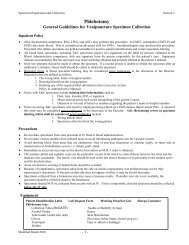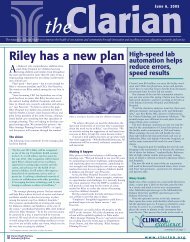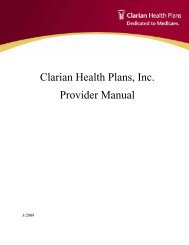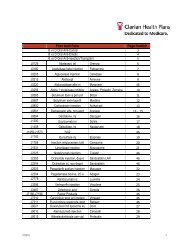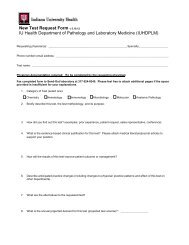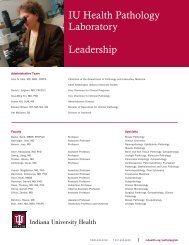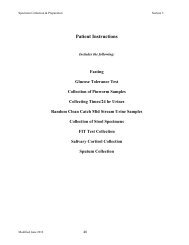Guidelines for Microbiology & Virology - IU Health
Guidelines for Microbiology & Virology - IU Health
Guidelines for Microbiology & Virology - IU Health
Create successful ePaper yourself
Turn your PDF publications into a flip-book with our unique Google optimized e-Paper software.
Specimen Preparation and Collection Section 3<br />
General <strong>Guidelines</strong> <strong>for</strong><br />
Blood Culture Collection<br />
TABLE 4: Recommendations <strong>for</strong> Blood Culture Collection<br />
Clinical Condition Collection Protocol Comments<br />
For Adults/Adolescents<br />
Severe Septicemia (2) Cultures prior to therapy One (1) 10-15 ML sample from each arm<br />
Acute Endocarditis<br />
(2) Cultures w/in 1-2 hr. of Space each collection at least 1 hr. apart with two<br />
Subacute endocarditis<br />
Low grade intravascular<br />
infection<br />
Bacteremia of unknown origin<br />
Patient on therapy<br />
evaluation and prior to therapy<br />
(2) Cultures w/in 24 hr. on<br />
day (1). If negative 24 hr. later,<br />
obtain (2) more<br />
(2) separate venipunctures<br />
Space each collection at least 1 hr. apart. Patients<br />
receiving antibiotics prior to admission, obtain two<br />
(2)separate cultures on each of three (3) successive<br />
days. Cultures should be incubated at least (14) days.<br />
*NOTE: contact the microbiology lab when cultures<br />
need to be held longer than (5) days.<br />
(2) Cultures w/in 24 hr. Specimens should be collected at Least 1 hr. apart<br />
at first sign of febrile episodes.<br />
(4) Cultures w/in 48 hr. Take specimen immediately prior to next dose of<br />
antibiotic. Cultures should be incubated <strong>for</strong> at<br />
least (14) days *NOTE: contact the microbiology<br />
lab when cultures need to be held longer than (5) days<br />
Febrile Episodes<br />
No more than two (2) total<br />
cultures<br />
Bacteremia may precede episodes of fever and<br />
chills by about one (1) hr.<br />
Small Children (< 4 years) 1-2 ML. samples (2) Cultures usually suffice <strong>for</strong> diagnosing bacteremia<br />
in the newborn. Less than 1 mL of blood will detect<br />
Bacteremia when concentration of organism is<br />
sufficiently high. If so, inoculate (1)Peds Plus bottle.<br />
♦<br />
♦<br />
♦<br />
♦<br />
♦<br />
♦<br />
♦<br />
♦<br />
♦<br />
♦<br />
♦<br />
The volume of blood <strong>for</strong> culture is critical! Concentration of organisms in most cases of Bacteremia is low, especially<br />
if the patient is on antimicrobial therapy.<br />
Most cases of Bacteremia are detected using 2 sets of separately collected blood cultures. More that 2 sets yield little<br />
additional in<strong>for</strong>mation.<br />
In children less than four, the concentration of organisms during bacteremia is higher than those four years and older;<br />
there<strong>for</strong>e, less blood is acceptable <strong>for</strong> culture utilizing the Peds Plus bottles.<br />
The yield of blood cultures in adults increases approximately 3% per ml of blood cultured. Culture bottles with<br />
inadequate blood volumes may demonstrate no growth when in fact microorganisms are present in the blood. To<br />
accurately ascertain bacteremic episodes and obtain the best sensitivity, the maximum amounts of blood (specified on<br />
the collection bottles) should be obtained <strong>for</strong> culture.<br />
One blood culture “set” is defined as a sample of blood drawn at a single time at a single site, regardless of how many<br />
bottles are injected into. These “sets” typically should be collected ten minutes apart unless ordered otherwise. For<br />
blood cultures obtained from an intravascular line it is permissible to obtain both “sets” with one large volume draw.<br />
Ideally blood cultures are obtained from peripheral venipuncture (i.e. - two sets from two separate venipunctures).<br />
Draw blood cultures prior to initiating or changing antimicrobial therapy if at all possible.<br />
Aseptic technique is critical to obtaining accurate results. When obtaining specimens via skin puncture, a second person<br />
may be needed to assist in extremity stabilization and to place blood into bottles while pressure is held over puncture site.<br />
Inpatient Collection Policy<br />
RN’s, LPN’s, AST’s, house staff or physicians who have received competency validation in blood culture specimen<br />
collection may draw Blood cultures.<br />
A physician’s order is required to obtain blood cultures from an intravascular line. It is critical to label the specimen with<br />
the specific line it is drawn from (eg - arterial, PICC, etc.).<br />
Blood can be collected from veins, arteries, or intravascular catheters<br />
Modified March 2010 - 6 -




